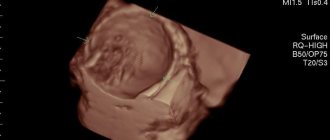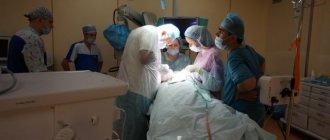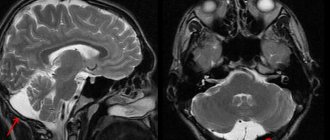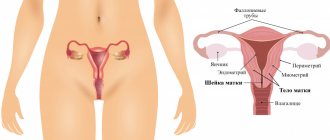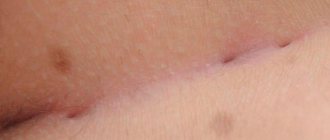Ovarian cyst in women
(ICD-10 classification N83) is a fluid-filled protrusion that forms on the surface of one or both ovaries of women, in most cases from a follicle. Anatomically, the cyst looks like a thin-walled cavity in the form of a sac. The size of this formation ranges from a few to 15–20 centimeters in diameter.
In 90% of cases, the cyst is functional, or follicular. The reason for its appearance is the “overripening” of the follicle - a special formation in which the female reproductive cell develops. The thing is that each menstrual cycle, one of the two ovaries normally produces one egg, which, when mature, must leave the follicle into the fallopian tube, and the ruptured follicle becomes the corpus luteum, which produces the hormone progesterone. This is the essence of ovulation.
A cyst is formed if the follicle does not rupture, but fills with fluid and remains in the ovary. Sometimes its size begins to create inconvenience, blocking the exit to the fallopian tube and causing discomfort. But most often, the follicular cyst resolves during the next menstruation, without leaving any visible marks.
A functional cyst can also be caused by an expansion of the corpus luteum. It has the same principles of formation and is called a corpus luteum cyst.
Another type of functional cyst is a hemorrhagic cyst, when blood vessels rupture inside the follicle or corpus luteum and hemorrhage occurs, accompanied by pain.
There is also a dysontogenetic cyst, which is formed as a result of disturbances in the growth and development of the ovaries during puberty, as well as a tumor cyst, which gives rise to ovarian cancer.
Corpus luteum cyst of the ovary
The corpus luteum is a cyclically formed gland in the ovary, which appears at the site of the ovulated Graafian vesicle (follicle) and produces the hormone progesterone. The name of the gland was given by the lipochrome pigment present in its cells and giving them a yellowish color. The corpus luteum develops in the ovary during the second (luteal) phase of the menstrual cycle. At the flowering stage, the corpus luteum reaches a size of 1.5–2 cm and one pole rises above the surface of the ovary.
In the absence of fertilization, the corpus luteum at the end of the luteal phase undergoes involutive development and stops producing progesterone. When pregnancy occurs, the corpus luteum does not disappear, it continues to grow and function for another 2-3 months and is called the corpus luteum of pregnancy.
Features of a corpus luteum cyst
An ovarian luteal cyst is formed from a corpus luteum that has not undergone regression, in which, due to circulatory disorders, fluid of a serous or hemorrhagic nature accumulates. The size of an ovarian corpus luteum cyst is usually no more than 6–8 cm. An ovarian corpus luteum cyst occurs in 2–5% of women of reproductive age after the establishment of a two-phase menstrual cycle.
Clinical gynecology differentiates corpus luteum cysts that develop outside of pregnancy (from an atretic follicle), as well as corpus luteum cysts that arise during pregnancy. The corpus luteum cyst of the ovary is often unilateral, single-cavitary; has a capsule lined from the inside with granular luteal cells, filled with reddish-yellow contents. The spontaneous disappearance of the ovarian corpus luteum cyst occurs within 2-3 menstrual cycles or in the second trimester of pregnancy.
Causes of formation of ovarian corpus luteum cyst
The reasons for the formation of ovarian corpus luteum cysts are not completely clear. It is believed that the formation of a corpus luteum cyst is caused by hormonal imbalance and impaired blood circulation and lymph drainage in the ovarian tissues. The risk of luteal cyst formation increases while taking drugs to stimulate ovulation in case of infertility or preparation for IVF (for example, clomiphene citrate) and emergency contraception.
The possibility of the formation of a cyst of the corpus luteum of the ovary under the influence of heavy physical and mental stress, harmful production conditions, malnutrition (mono-diet), frequent oophoritis and salpingo-oophoritis, and abortion cannot be ruled out. All these factors can lead to endocrine imbalance, and, consequently, the formation of an ovarian corpus luteum cyst.
Service available
Operating mode
Mon-Sat: 8:00 - 21:00 Sun: 9:00 - 21:00 emergency room: 24 hours a day
Taking tests
Mon-Sun: from 8:00 to 20:00
North Branch
+7
St. Petersburg, 197372, st. Ilyushina, 4, building 1
Komendantsky Avenue
Operating mode
Daily from 08:00 to 21:00 Sunday: from 09:00 to 21:00 Trauma Department: from 08:00 to 21:00
Taking tests
Mon-Sun: from 8:00 to 20:00
Ozerki branch
+7 (adult department) (children's department)
St. Petersburg, 194354, Uchebny lane, 2
Ozerki
Operating mode
Symptoms of ovarian corpus luteum cyst
Symptoms of an ovarian corpus luteum cyst are mild. Luteal cysts often develop over a period of 2–3 months, after which they spontaneously and suddenly involute.
An ovarian corpus luteum cyst detected during pregnancy does not pose a threat to the woman and the fetus. On the contrary, the absence of the corpus luteum of pregnancy in the early stages can cause spontaneous abortion due to hormonal deficiency. Reverse development of ovarian corpus luteum cysts during pregnancy also most often occurs spontaneously by 18–20 weeks. gestation: by this time, the formed placenta completely takes over the hormone-producing functions of the corpus luteum.
Small cysts may not show any symptoms, but as they increase in size, symptoms will certainly appear. All external manifestations and complaints of women who have an ovarian cyst can be divided into several groups:
- Painful sensations.
Pain can occur on the right or left, in the lower abdomen or in the sacral area. The severity varies from a dull aching sensation to severe shooting pains that can radiate to the side, leg, lower back or anus. - Menstrual irregularities.
Against the background of an ovarian cyst, any changes in menstruation are possible. Most often there are: heavy and frequent menstruation; rare and scarce; absence of critical days for several months; unsystematic arrival of menstruation. - Endocrine manifestations.
Hormonal disorders associated with ovarian cysts can manifest themselves in a variety of symptoms: obesity; hair growth that is atypical for a woman (dark hairs above the upper lip, the appearance of hair on the chest around the nipples and from the pubis to the navel); skin changes (acne, seborrhea); sexual disorders (lack of libido, pain and discomfort during sexual intercourse); the occurrence of gynecological problems (endometrial hyperplasia, uterine polyp, uterine fibroids); impaired reproductive function (infertility, miscarriage). - Changes in neighboring organs.
An ovarian tumor of medium and large size (more than 6–10 cm in diameter) can compress the pelvic organs, which will manifest itself as disturbances in urination and defecation (intestinal obstruction, difficulty emptying the bladder). Large tumors (more than 15 cm) extending beyond the pelvis can put pressure on the overlying organs.
Sometimes an ovarian corpus luteum cyst can cause slight pain, a feeling of heaviness, fullness, and discomfort in the abdomen on the developmental side. A luteal cyst that produces progesterone can cause delayed menstruation or, conversely, prolonged menstruation due to uneven shedding of the endometrium. Luteal ovarian cysts never become malignant.
Most often, symptoms develop with a complicated course of the corpus luteum cyst of the ovary - torsion of the pedicle, hemorrhage into its cavity or ovarian apoplexy. In all these cases, a clinical picture of an acute abdomen is observed - cramping acute pain of a diffuse nature, vomiting, tension and sharp pain in the abdomen, positive peritoneal symptoms, gas and stool retention, disappearance of peristaltic noises, intoxication, etc.
Diagnosis of ovarian corpus luteum cyst
Diagnosis of an ovarian corpus luteum cyst is carried out taking into account anamnesis, complaints, gynecological examination data, ultrasound, and laparoscopy. Vaginal examination reveals a tight elastic formation on the side of the uterus or behind it, which has limited mobility and sensitivity to palpation. Echoscopically, a corpus luteum cyst is defined as an anechoic, homogeneous, round formation, 4 to 8 cm in diameter, with smooth, clear contours, sometimes with a fine suspension inside.
To accurately recognize a luteal cyst, a dynamic ultrasound is performed in the first (follicular) phase of the menstrual cycle. Carrying out color Dopplerography (CDC) is aimed at excluding vascularization of the internal structures of the cyst and differentiating retention formation from true ovarian tumors.
As with other identified ovarian tumors and cysts, a study of the CA-125 tumor marker is indicated. To exclude or confirm pregnancy, a determination of human chorionic gonadotropin and a pregnancy test are performed. In cases where it is difficult to differentiate a corpus luteum cyst from other neoplasms (ovarian cystoma, theca lutein ovarian cysts with chorionepithelioma and hydatidiform mole, etc.) and ectopic pregnancy, diagnostic laparoscopy is required.
Thus, for the examination and diagnosis of this pathology, the following is used:
- CT (computed tomography) and MRI (magnetic resonance imaging).
- Transvaginal ultrasound examination.
- Laparoscopy, with simultaneous removal of a cyst when detected.
- Hormone analysis: LH and FSH, estrogen and testosterone.
- Puncture of the pouch of Douglas (posterior vaginal vault) if internal bleeding is suspected due to a ruptured cyst.
- Analysis for tumor marker CA-125 to exclude ovarian cancer.
- Pregnancy tests are also mandatory, not only because the treatment for pregnant and non-pregnant women is different, but also to exclude ectopic pregnancy, the symptoms of which are similar to those of an ovarian cyst.
Our equipment
In our work we use the latest achievements of world practice. Our doctors conduct ultrasound examinations using expert-level devices, such as GE LOGIQ E9, GE VIVID 9, GE VOLUSON E8, GE VOLUSON E10.
The VOLUSON E10 ultrasound machine is equipped with a special electronic sensor that allows doctors to diagnose fetal malformations, assess the risk of hereditary pathology, and pregnancy complications with maximum accuracy. From the earliest stages, using the unique Radience Flow modes, it is possible to assess the structures of the fetal heart with maximum accuracy and exclude developmental defects, and the widest range of 3D and 4D capabilities, including the HD life visualization mode, makes it possible not only to evaluate in detail the anatomy of the internal organs of the fetus, but also to see your baby with maximum realism from the very beginning of pregnancy.
Treatment of ovarian corpus luteum cyst
Patients with a small and clinically silent corpus luteum cyst of the ovary are recommended to be observed by a gynecologist, ultrasonic dynamic control and color circulation for 2–3 menstrual cycles. During this period, the cyst may undergo regression and completely disappear.
Symptomatic and recurrent ovarian corpus luteum cysts can also resolve under the influence of conservative anti-inflammatory therapy, selection and prescription of hormonal contraceptives, balneotherapy (therapeutic baths and vaginal irrigation), peloid therapy, laser therapy, SMT phoresis, electrophoresis, ultraphonophoresis, magnetic therapy.
During the period of treatment for ovarian corpus luteum cysts, physical activity and sexual activity are limited in order to avoid torsion or rupture of the tumor-like formation. If the luteal cyst does not resolve within 4–6 weeks, the issue of its surgical removal is decided.
Planned intervention for a corpus luteum cyst is most often limited to laparoscopic enucleation of the cyst within the unchanged ovarian tissue and suturing its wall or resection of the ovary. In case of complications (necrotic changes in ovarian tissue, bleeding, etc.), emergency laparotomy with oophorectomy is indicated.
Our advantages
- Our medical center employs doctors with extensive practical experience.
- We have a special innovative design of operating rooms: infection-resistant seamless monolithic blocks, 5 levels of sterility, thanks to a complex ventilation system.
- The gynecology department is equipped with the latest generation equipment - surgical equipment from recognized global manufacturers of medical equipment - “Karl Storz”, “Covidien”, “Erbe”, etc.
- All procedures are carried out in the most comfortable conditions for the patient.
You can see prices for services
Prevention and prognosis for ovarian corpus luteum cyst
Prevention of the formation of functional ovarian cysts is facilitated by timely and complete treatment of inflammation of the organs of the reproductive system, as well as correction of disturbed hormonal balance. Observation by a gynecologist-endocrinologist and ultrasound control when identifying an ovarian corpus luteum cyst allows you to take the necessary measures in a timely manner and prevent complications.
An ovarian corpus luteum cyst does not pose a threat to a developing pregnancy. With spontaneous regression or planned removal of the ovarian corpus luteum cyst, the prognosis is favorable.
Pregnancy management
When a long-awaited pregnancy occurs, you really need to find your doctor. This should be a person you can trust, with whom you can easily find mutual understanding, who respects privacy and confidentiality. These are the kind of obstetricians and gynecologists who work in Scandinavia to make pregnancy as easy as possible, and the birth of a baby remains a joyful memory.
You can find our pregnancy management programs here.
Department of Pregnancy Pathology
Despite the naturalness of the process, not every pregnancy goes smoothly, and you need to be prepared for this. Therefore, in Scandinavia, the pregnancy pathology department operates around the clock: you can come here if you have any symptoms or complications and count on timely and high-quality help.
Reviews
Olga, 35 years old 12/15/2016
An endometriotic ovarian cyst was just removed. There were a lot of fears before the operation. Moreover, there was an operation to remove appendicitis and the anesthesia did not affect me; I felt all the pain, but I could not move. Before the operation, I talked with the anesthesiologist and said that if this happens, I won’t chew it again. Everything went well. If you have such a cyst, I advise you to remove it. You can’t play sports, you can’t steam or sunbathe with such a cyst, it can burst. You walk around like a crystal vase, afraid that it will burst. It can cause infertility and develop into oncology; during pregnancy with such a cyst, fetal death may occur.
Lisa, 25 years old 01/19/2017
I, too, was recently diagnosed with a cyst, but they can’t determine which one, 7 cm long and 5 cm in diameter!!!!!! I drank escapelle a year ago, perhaps it was because of it, because I had a hormonal disorder, and was prescribed rigevidon!!!!!!! I don’t know whether it will help or not!!!!!!!!!!! tell me what else besides hormonal drugs can be used to treat a cyst?????????
Marusya, 28 years old 02/25/2017
Elizaveta, I would advise you to contact the Doctor Nearby clinic on Ozernaya. There doctors specialize specifically in women's diseases. I myself was hospitalized there with a cyst and was very pleased.
Margot 03/30/2017
2 weeks ago my cyst burst during sex, the pain was terrible, I couldn’t get up, they would turn around - in short, it was very painful. We called an ambulance. I was referred to gynecology and a ruptured cyst was diagnosed. In general, the operation was performed at night, and everything ended successfully. Before this, a year ago I was diagnosed with a follicular cyst, I was treated for about half a year with pills, injections, etc. During the next examination, it was determined that it had successfully resolved. I was deregistered and now...
